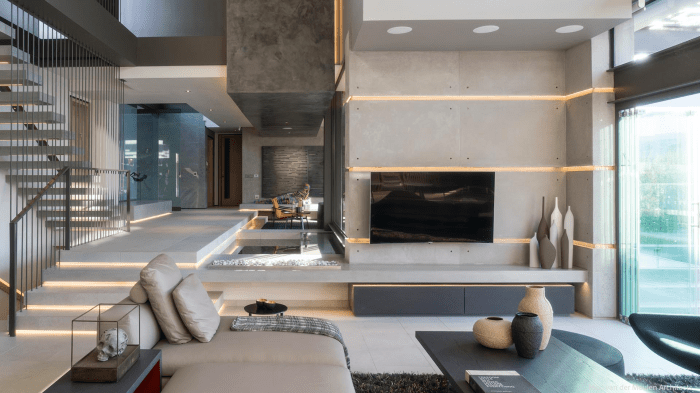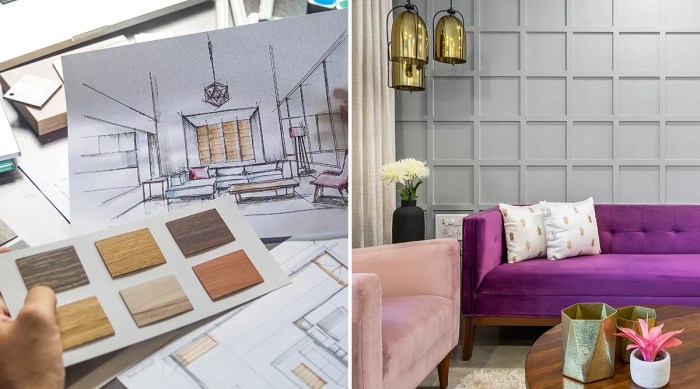Crafting Spaces: Architect and Interior Designer Unveiled

As architect and interior designer take center stage, this opening passage beckons readers into a world crafted with good knowledge, ensuring a reading experience that is both absorbing and distinctly original.
In the following paragraphs, we will dive into the intricacies of these professions, shedding light on their roles, responsibilities, and collaborative efforts in the realm of design.
Overview of Architect and Interior Designer
An architect is a professional who designs and plans the construction of buildings and structures. They are responsible for creating functional and aesthetically pleasing spaces while ensuring the safety and well-being of occupants. On the other hand, an interior designer focuses on creating interior spaces that are not only visually appealing but also functional and practical for the inhabitants.
Roles and Responsibilities
- Architects:
- Designing and planning the overall structure and layout of buildings.
- Incorporating building codes, regulations, and safety standards into the design.
- Collaborating with engineers, contractors, and clients to bring the design to life.
- Interior Designers:
- Selecting and arranging furniture, fixtures, and decorative elements for interior spaces.
- Considering aspects such as lighting, color schemes, and materials to enhance the functionality and aesthetics of a space.
- Working closely with clients to understand their needs, preferences, and budget constraints.
Skill Sets Comparison
While both architects and interior designers are creative professionals involved in shaping spaces, they require different skill sets:
| Architects | Interior Designers |
|---|---|
| Strong understanding of structural engineering and construction methods. | Expertise in color theory, textiles, and spatial arrangement. |
| Ability to create detailed technical drawings and blueprints. | Proficiency in selecting materials, finishes, and furnishings. |
| Knowledge of building codes and regulations. | Skills in space planning and layout design. |
Education and Training

Both architects and interior designers undergo specific educational paths and training to excel in their respective fields.
Architects
Typically, the educational path to become an architect involves the following steps:
- Completion of a bachelor's degree in architecture from an accredited program.
- Participation in an internship program to gain practical experience.
- Passing the Architect Registration Examination (ARE) to become a licensed architect.
Interior Designers
To practice as an interior designer, individuals usually need:
- Completion of a bachelor's degree in interior design or a related field.
- Training through internships or entry-level positions to develop design skills.
- Obtaining certifications such as the National Council for Interior Design Qualification (NCIDQ) exam for licensure.
Specialized Courses and Additional Qualifications
Both architects and interior designers can benefit from specialized courses or additional qualifications to enhance their skills and knowledge. Some of these include:
- LEED certification for sustainable design practices.
- AutoCAD or Revit training for proficiency in design software.
- Continuing education courses to stay updated on industry trends and regulations.
Design Process
When it comes to the design process in architecture and interior design, there are specific steps followed to bring a project from concept to reality. Architects and interior designers work closely with clients to ensure their vision is captured and executed effectively.
Architectural Design Process
- Conceptualization: Architects start by understanding the client's needs and project requirements before creating initial design concepts.
- Schematic Design: This phase involves developing the design further, including floor plans, elevations, and rough sketches.
- Design Development: Architects refine the design, incorporating structural, mechanical, and electrical systems into the plans.
- Construction Documentation: Detailed drawings and specifications are created to guide the construction team in building the project.
- Construction Administration: Architects work during the construction phase to ensure the design is implemented correctly and address any issues that may arise.
Interior Design Process
- Client Consultation: Interior designers meet with clients to understand their preferences, style, and functional needs for the space.
- Space Planning: Designers create layouts and floor plans to optimize the functionality and flow of the space.
- Material Selection: From furniture to finishes, interior designers help clients choose materials that align with their vision and budget.
- Color and Lighting Design: Designers consider the impact of color and lighting on the space, creating ambiance and enhancing the overall design.
- Finalization and Implementation: Once all decisions are made, interior designers oversee the installation and styling of the space to bring the design to life.
Collaboration between Architects and Interior Designers
Architects and interior designers often collaborate on projects to ensure a cohesive and harmonious design. They work together to marry the exterior architecture with the interior spaces, creating a seamless transition between the two. By combining their expertise, architects and interior designers can deliver a comprehensive design that meets the needs and preferences of the client while maintaining the project's overall vision.
Tools and Software
Architects and interior designers rely on a variety of tools and software to bring their design concepts to life, streamline the design process, and enhance collaboration with clients and other professionals.
Essential Tools and Software for Architects
- AutoCAD: Widely used for creating architectural drawings and drafting.
- Revit: Allows architects to design in 3D and create building information models (BIM).
- SketchUp: Ideal for creating 3D models and visualizations of architectural designs.
- Adobe Creative Suite: Includes Photoshop, Illustrator, and InDesign for graphic design and presentations.
- 3ds Max: Used for rendering and creating realistic visualizations of architectural designs.
Role of Technology in Interior Design
Technology plays a crucial role in aiding interior designers throughout the design process. From creating mood boards to producing detailed floor plans, software tools help interior designers visualize and communicate their design ideas effectively.
Software Applications Comparison
| Architects | Interior Designers |
|---|---|
| AutoCAD | AutoCAD |
| Revit | SketchUp |
| SketchUp | Adobe Creative Suite |
| Adobe Creative Suite | 3ds Max |
Summary

In conclusion, the dynamic interplay between architects and interior designers creates harmonious spaces that blend functionality and aesthetics seamlessly. This discussion highlights the artistry and precision required in these fields, paving the way for innovative and captivating designs in the modern world.
Question & Answer Hub
What are the primary responsibilities of an architect?
Architects are primarily responsible for designing and overseeing the construction of buildings, ensuring structural integrity, safety, and functionality.
What certifications are needed to practice as an interior designer?
Interior designers typically need a bachelor's degree in interior design and may also pursue certifications like NCIDQ for professional practice.
How do architects and interior designers collaborate on projects?
Architects and interior designers collaborate by sharing ideas, creating cohesive design concepts, and working together to bring a client's vision to life.

